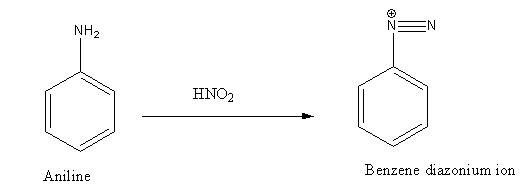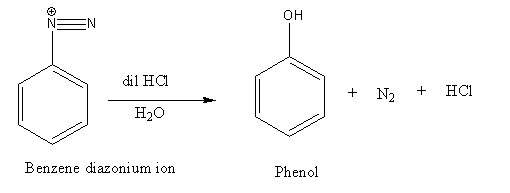
Reaction of aniline with
A)
B)
C)
D)
Answer
470.7k+ views
2 likes
Hint:Aniline reacts similarly to primary aliphatic amines. Aniline gives diazonium ion after treatment with nitrous acid. On further treatment with dilute acid undergo hydrolysis reaction.
Complete solution:
In this reaction, aniline is the reactant and reagent given to us is nitrous acid,
Aniline is the simplest aromatic amine that behaves similarly to primary aliphatic amines. It consists of an amino group bonded to a phenyl group.
Reagent nitrous acid is prepared by reaction of sodium nitrite with hydrochloric acid. It is a weak acid
Now, we will see the reaction mechanism when of aniline reacts with
Step 1: Conversion of aniline to diazonium ion using nitrous acid,

Step 2: Diazonium ion on further treatment with dilute acid undergoes hydrolysis reaction and gives phenol as the product.

Thus, the correct options are (B).
Note:Aromatic diazonium ion is a very important intermediate to produce substituted benzene. The final product depends on reagent use. Here the reagent used is dilute acid so the diazonium ion undergoes a hydrolysis reaction. The addition of water molecules is known as the hydrolysis reaction. Amines on hydrolysis give alcohol as the product while aniline gives phenol as the product.
Complete solution:
In this reaction, aniline is the reactant and reagent given to us is nitrous acid,
Aniline is the simplest aromatic amine that behaves similarly to primary aliphatic amines. It consists of an amino group bonded to a phenyl group.
Reagent nitrous acid is prepared by reaction of sodium nitrite with hydrochloric acid. It is a weak acid
Now, we will see the reaction mechanism when of aniline reacts with
Step 1: Conversion of aniline to diazonium ion using nitrous acid,

Step 2: Diazonium ion on further treatment with dilute acid undergoes hydrolysis reaction and gives phenol as the product.

Thus, the correct options are (B).
Note:Aromatic diazonium ion is a very important intermediate to produce substituted benzene. The final product depends on reagent use. Here the reagent used is dilute acid so the diazonium ion undergoes a hydrolysis reaction. The addition of water molecules is known as the hydrolysis reaction. Amines on hydrolysis give alcohol as the product while aniline gives phenol as the product.
Latest Vedantu courses for you
Grade 9 | CBSE | SCHOOL | English
Vedantu 9 CBSE Pro Course - (2025-26)
School Full course for CBSE students
₹37,300 per year
Recently Updated Pages
Master Class 9 General Knowledge: Engaging Questions & Answers for Success

Master Class 9 English: Engaging Questions & Answers for Success

Master Class 9 Science: Engaging Questions & Answers for Success

Master Class 9 Social Science: Engaging Questions & Answers for Success

Master Class 9 Maths: Engaging Questions & Answers for Success

Class 9 Question and Answer - Your Ultimate Solutions Guide

Trending doubts
Give 10 examples of unisexual and bisexual flowers

Draw a labelled sketch of the human eye class 12 physics CBSE

Differentiate between homogeneous and heterogeneous class 12 chemistry CBSE

Differentiate between insitu conservation and exsitu class 12 biology CBSE

What are the major means of transport Explain each class 12 social science CBSE

Why is the cell called the structural and functional class 12 biology CBSE




